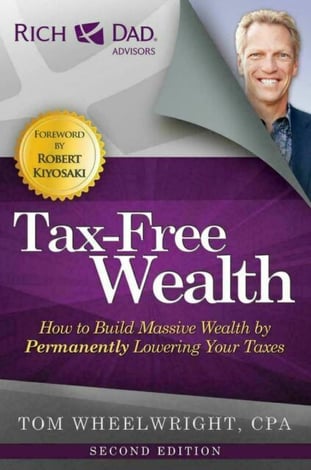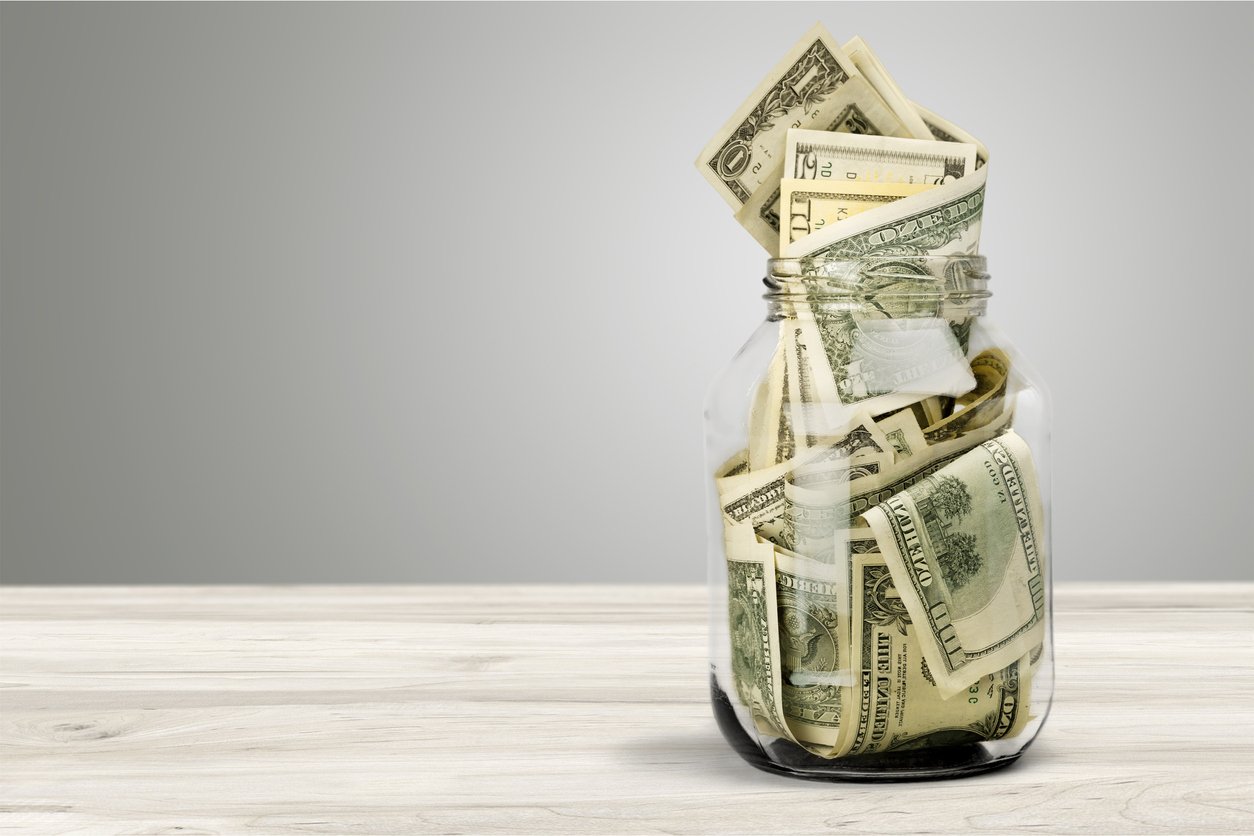Tom Wheelwright, the author of Tax-Free Wealth: How to Build Massive Wealth by Permanently Lowering Your Taxes, is an entrepreneur, best selling author, Rich Dad Advisor, a CPA, and an international authority on tax. In his own words, “My goal in life is to make taxes fun, easy & understandable!”

With more than 200 reviews on Amazon and a rating 4.3 out of a possible 5 stars, Tax-Free Wealth shows businesspeople, entrepreneurs, and real estate investors how to build massive amounts of wealth by using practical and strategic ways to permanently reduce taxes.
Tom has also contributed to a number of other Rich Dad books, including The Real Book of Real Estate, Rich Dad Success Stories, Who Took My Money, Unfair Advantage, and Why The Rich Are Getting Richer.
Key Takeaways / Lessons Learned
While it’s true that managing your taxes can be outsourced to an accountant or CPA, successful real estate investors always have a solid understanding of the factors that affect their financial future.
Having basic knowledge in areas such as zoning, leasing, property management, and taxes helps you to understand if you’re getting the best advice and making the right decisions.
When you go to the doctor or take your car into the garage, you’re relying on an expert. But you still want to have a basic idea of how your body works or how your car runs before making a decision on a costly procedure or repair.
Fundamental principles of tax law and investing
By understanding the fundamental principles of how taxes work and what tax laws are written for, you’ll be able to tailor your investing strategy and arrange your finances to reap the rewards of today’s real estate-friendly tax system.
Core lessons covered in Tom Wheelwright’s Tax-Free Wealth include:
- Local, state, and federal governments create incentives with tax laws in an attempt to encourage specific activities that benefit the economy and promote social policy
- Tax laws are written mainly with the goal of stimulating growth, not raising tax revenue
- Gross income is about how much you make, but net income is more important because it’s what’s left over when everything is said and done
- Every step you take in business – or your personal life – has an affect on how much tax you pay at the end of the day
- Because of the pervasive impact of taxes, tax planning should be done daily instead of at the end of the year
- Of the four types of income earners – employees, self-employed people, business owners, and investors – the two types of people who can benefit most from the tax code are business owners/entrepreneurs and investors
- Passive income – such as monthly rental income and property sales gains – are taxed at lower rates than other types of income
- Strategic estate planning is a key way to permanently lower the taxes your pay
- One of the biggest advantages to investing in real estate is gaining access income deductions offered by the tax law in the U.S.
- Many real estate investors have little or no taxable income while having plenty of positive cash flow by employing powerful tax strategies in their business
- Owning real estate in a legal entity structure such as an LLC helps to lower taxes and protects you and your assets from legal claims and personal liabilities
For this book review, we’ve selected a couple of chapters to highlight below. We’ll start with the introduction to lay the foundation.

Introduction by Robert Kiyosaki
Tax-Free Wealth: How to Build Massive Wealth by Permanently Lowering Your Taxes begins with a forward by Robert Kiyosaki. The author of Rich Dad Poor Dad acknowledges that the only two certain things in life are death and taxes. But if you’re smart, you’ll do everything you can to put both off as long as you can.
Living longer means doing things like exercising, eating right, and generally living a healthy lifestyle, both physically and mentally. And while it’s very difficult to pay $0 taxes, there are quite a few things you can do as a real estate investor to permanently reduce the amount of tax you pay.
Lowering your taxes begins with understanding the four types of people that make up the “Cashflow Quadrant”:
- E = Employee
- S = Self-employed
- B = Big business owner
- I = Investor
Although it may be counterintuitive, employees and self-employed people usually pay the highest percentage of taxes even though they make much less money than business owners or investors. That’s because they don’t understand the rules of the tax game.
As Kiyosaki notes in his introduction, taxes are killing many people financially. Governments legally are taking larger and larger amounts of money from the middle class – which according to the Pew Research Center is people making between $40,500 and $122,000 per year.
The fact is that local, state, and federal governments write tax codes to encourage or discourage certain behavior. So, if your city or town wants to see more work-force housing or urban development, they’ll create tax incentives for real estate investors to put capital into affordable housing or inner-city projects. On the other hand, if a municipality wants to discourage suburban sprawl, development will become more difficult, expensive, and time consuming.
Rather than cheating on their taxes, the most successful real estate investors use government incentives and the tax code to their advantage. As Tom Wheelwright notes in his book, you can receive tax breaks through business and rental property deductions without having to worry about an agent from the IRS knocking on your front door.
The Two Most Important Rules
“Any one may so arrange his affairs so that his taxes shall be as low as possible; he is not bound to choose that pattern which will best pay the Treasury. There is not even a patriotic duty to increase one’s taxes.”
Chapter 3 of Tax-Free Wealth begins with the above quote from Judge Learned Hand, who served on the United States Court of Appeals for the Second Circuit. What Judge Hand said may sound shocking to some readers, because after all, we’re trained to believe that somehow we owe money to the government.
But in reality, the tax code is written to help investors and businesspeople legally reduce their tax burden. By not taking advantage of tax breaks, you’re literally robbing yourself, your family, and your financial future.
There are two simple rules when it comes to tax law:
Rule #1: It’s your money, not the government’s. You may be required to give some of your hard earned money to the government for things like schools, roads, and defense. But ultimately, it’s your money and not “theirs”.
Rule #2: The tax law is written primarily to reduce your taxes. Tom Wheelwright writes that 99.5% of tax law is written to reduce your taxes. Even though the tax code may seem complex, it’s really aimed at reducing your taxes, not increasing them.
Surprisingly, many tax advisors aren’t aware of these two simple rules and end up working for the government by not helping you lower your taxes as much as possible.
There are two reasons for this. First, many tax advisors are actually afraid of the tax law and won’t spend the time and effort learning how to take advantage of the law for you. Second, some advisors are afraid of making a mistake, so instead of helping you reduce your taxes their focus is on protecting themselves.

Entrepreneurs and Investors Get All the Breaks
The general public likes to complain that businesspeople get “unfair” tax advantages. In fact, some very well known real estate investors are famous for paying no taxes at all while being multimillionaires.
When some people say the tax code isn’t fair, they’re overlooking the fact that virtually anyone in the U.S. can form a business and reap the various benefits of our country’s tax code. As Chapter 3 of Tax-Free Wealth explains, it’s also one of the many reasons why investing in real estate is a tried and true way to generate income, build wealth, while at the same time permanently lowering taxes.
Let’s revisit the Cashflow Quadrant:
- E = Employee
- S = Self-employed
- B = Big business owner
- I = Investor
While it’s true that business owners, entrepreneurs, and investors pay much less tax and employees and self-employed people, the big question is ‘Why?’. Tom Wheelwright believes that the reason the B and I people pay less tax is because that’s what Congress wanted.
Remember when Robert Kiyosaki wrote in the introduction to Tax-Free Wealth that tax law is written to encourage certain economic behavior? That’s exactly what the tax code does. The government wants business owners and entrepreneurs to create jobs, and real estate investors to create housing.
When you think about it, all the tax breaks that real estate investors get act as subsidies to encourage more housing. This helps local economies by making it easier to attract employers, good paying jobs, and strong population growth.
Earlier in this section we wrote that anyone in the U.S. can start a business. While that’s absolutely true, you shouldn’t start a business just for the potential tax benefits. To legally get tax benefits, the business needs to be real and intended to make a profit. Also, it’s critical to get educated before you start a business. That’s because paying taxes is less expensive than failing at a business.
Earn Better Income
“The only difference between death and taxes is that death doesn’t get worse every time Congress meets.” – Will Rogers
In every country there are different types of income, and each type of income has different tax rates, costs, and benefits. So, when you’re trying to permanently lower your taxes, it makes good business and financial sense to choose the most tax-efficient ways to earn income.
Employees who work for someone else, and self-employed people, make their money by “earning income”. Earned income - or salary - is taxed at the highest rate possible in the U.S., which is why these two groups from the Cashflow Quadrant pay a disproportionate share of taxes. To make matters worse, earned income is subject to additional taxes such as payroll tax, unemployment tax, and social security taxes.
Now look at the two other groups from the Cashflow Quadrant, business owners and investors. While it’s true that they receive some of their money as earned income or salary, most of the income they receive is from their business or investments. The business ‘net income’ they receive is after deducting as many legal expenses as possible from the business or investment cash flow.
Employees and self-employed people are generally limited to three possible deductions, assuming they own a house or condo: 1) Mortgage interest, 2) Property taxes, 3) Charitable donations. If they rent where they live, they’ve only got one possible deduction – charity.
Next, compare that to the possible deductions you have as a business owner or real estate investor to reduce the amount of your taxable income:
- Mortgage interest
- Property taxes
- Charitable donations
- Business supplies
- Business equipment
- Marketing expenses for your business
- Home office business expenses
- Vehicle used for business
- Meals and entertainment for discussing business
- Travel
In addition to these, when you own rental real estate, you can also deduct expenses from your rental property cash flow to reduce the net income before making additional deductions like the ones above. Common real estate tax deductions used to reduce taxable net income include:
- Closing costs
- Property management fees
- Leasing fees
- Maintenance and repair expense
- Supplies for the property
- Depreciation
Another way of looking at the different types of income is to think of income as “buckets of money”. Below are the five money buckets discussed in Tax-Free Wealth:
- Bucket #1: Earned income from a job = high income taxes and high employment taxes
- Bucket #2: Ordinary income from a pension or retirement plan = high income taxes
- Bucket #3: Investment income from dividends or capital gains = lower income taxes and in some cases (as with a 1031 tax deferred exchange) no income taxes
- Bucket #4: Gifts or Inheritance = no income taxes to the person receiving the gift or inheritance, in most cases
- Bucket #5: Passive income such as income received from a business or investment real estate = taxed at regular income tax rates after the passive income has been reduced with deductions
If you could put your income into one of these five buckets, which ones would you choose?

The Magic of Real Estate
“It’s tangible, it’s solid, it’s beautiful. It’s artistic, from my standpoint, and I just love real estate.” – Donald Trump
Chapter 19 of Tax-Free Wealth: How to Build Massive Wealth by Permanently Lowering Your Taxes explains what many professional real estate investors already know: Real estate is such a good tax shelter that a serious real estate investor should never have to pay tax on their cash flow or on the gain from the sale of their real estate.
In addition to reducing their taxable net income by expensing as much as possible, real estate investors have two additional ways to lower taxes and even defer the payment of taxes:
1. Depreciation
Depreciation is a non-cash deduction that as a real estate investor you can use to reduce your taxable net income. Your cash flow doesn’t change, so you still have the same amount of money to pay for expenses and generate profits, but by using depreciation your tax bill will go down.
The IRS allows owners of residential rental property to depreciate buildings and improvements (but not the land) at a rate of 3.636% per year over 27.5 years. At the end of that time, the property is fully depreciated.
For example, let’s assume you own a single-family rental property and the value of the house is $120,000. The tax benefit of depreciation allows you to reduce your taxable net income by $4,363 per year ($120,000 x 3.636%) for each year.
So, if the net income from your rental property – after making all of your other allowable deductions but before depreciation expense – was $5,000, your taxable net income after deducting for depreciation would be: $5,000 less $4,363 depreciation = $637.
You still have $5,000 in cash but only have taxable income of $637!
2. Like kind 1031 exchanges
Of course, when the government gives a tax benefit, they expect something in return. If you’re not careful, you can be liable for capital gains tax when you sell your rental property - often on both a state and federal level.
Let’s say after five years you decide to sell the single-family rental property from the above example. You’ve depreciated the house by $21,815 so your tax basis is $98,185. If the property has appreciated and now has a fair market value of $140,000, you’ll have a potential taxable capital gain of $41,815 ($140,000 market value less $98,185 tax basis).
In effect, you’re paying the government back for the depreciation deductions you’ve taken while you owned the property. You’re paying tax on the ‘depreciation recapture’ plus tax on the increase in property value.
However, the IRS gives real estate investors another tax benefit - called a 1031 tax deferred exchange – that allows you to defer paying taxes on that capital gain of $41,185 when you buy a like kind replacement property.
In addition to having extra money to invest by not paying taxes, the IRS defines “like kind” as any real estate used for business or investment purposes. Many real estate investors lower their taxes by conducting a like kind 1031 tax deferred exchange to reposition their portfolio from one asset class to another, such as selling commercial office or retail property and investing in single-family rental houses.
Is the Book Worth Reading?
Many people have mixed reactions after reading Tax-Free Wealth: How to Build Massive Wealth by Permanently Lowering Your Taxes by Tom Wheelwright. Some readers say the book is too generic and fluffy, while others praise Tax-Free Wealth for changing their view of how the tax system works.
Positives about the book
- Resonates with entrepreneurs, business owners, and investors who want to control their future and increase their wealth
- Written by an author who has a passion for taxes – something most people do not have – with thousands of pages of tax law distilled into one book
- Explains how to use the tax system to you advantage by using available incentives to maximize your tax savings, and not cheating on your taxes
Negatives about the book
- Promises a lot of “mind blowing” information but fails to deliver
- More motivational than educational, with too many general and oversimplified examples of how to lower your taxes
- Suggested tax strategies may be risky without professional guidance and mainly beneficial for investors in the top 5% economic bracket
Conclusion
Tax-Free Wealth: How to Build Massive Wealth by Permanently Lowering Your Taxes by Tom Wheelwright covers key concepts about taxes, tax law, and real estate investing including:
- How tax law is written to encourage certain types of economic behavior, and not to create tax revenue
- Why tax planning should be a daily activity instead of an end-of-the-year rush to find receipts and generate reports
- Four types of income earners and why the government wants wealthier people to pay less tax
- Five types of income buckets and which one leaves investors with more money in their pockets
- Why businesspeople, entrepreneurs, and investors get all the tax breaks
- What real estate investors can do to never pay tax on their cash flow or capital gains









